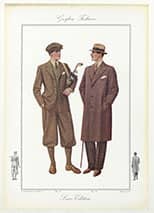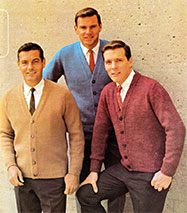A Stylish Timeline: Tracing the History of Men’s Fashion through the Decades
Welcome to a journey through the history of men’s fashion! From the stiff formalwear of the Victorian era to the grunge trend of the 90s and today’s Gen Z style, we will explore how men’s fashion has evolved over time. With each decade comes an entirely new look: from oversized suits in the 1900s to bright colors in the 1930s, to ready-to-wear styles in the 1940s. But one thing remains consistent — clothes have always been a way for people to express themselves and gain power. So ladies and gentlemen, let us begin our exploration of men’s fashion throughout history and discover how it has shaped who we are today.
Key Takeaways
- Men’s fashion has evolved significantly over time, from the sophistication and elegance of Victorian-era fashion to the daring and bold styles of the 2020s.
- Each decade had its own defining characteristics, such as the slim and tailored look of the 1900s, the structured shapes and luxurious fabrics of the 1920s, and the power dressing of the 1980s.
- Fashion in each era reflected societal trends and values, with the 1950s emphasizing conformity and projecting an image of success and professionalism, while the 1960s embraced individuality and self-expression.
- The 2010s saw a resurgence of vintage-inspired looks and unique individualism, while the 2020s are all about pushing boundaries, making a statement, and expressing oneself in a modern yet timeless way.
Victorian Era
During the Victorian Era, men’s fashion was all about sophistication and elegance – something that we still strive for today! Tailoring boasted sharp silhouettes in lavish fabrics like velvet and silk, while accessories such as pocket watches and top hats exuded a powerful presence. Footwear also played an important role, with stylish boots often featuring decorative details. Layering was key too, with gentlemen donning waistcoats and fine-knit jumpers to achieve elegant ensembles fit for any occasion. All these elements of style remain relevant today, proving that timeless class never goes out of fashion.
1900s Silhouette
In the ’90s, men’s silhouettes shifted towards a slimmer, more tailored look. Double-breasted jackets and waistcoats were in fashion, as well as slim-fit trousers. The ’90s silhouette was all about presenting a professional image while still maintaining an air of casualness. This decade also saw the rise of power suits – fitted suit jackets with broad shoulders and tapered waists – which gave men confidence and authority in the workplace. Men embraced this style to boost their presence and influence within any setting.
1920s Influence
In the 1920s, men’s fashion experienced a significant transformation, marking the beginning of a new era of style. The 1920s were characterized by a departure from the rigid and formal clothing of the past, embracing a more relaxed and casual approach. Men’s suits became looser and less structured, with high-waisted trousers and wide-legged pants replacing the previously popular tight-fitting styles. The iconic double-breasted jacket with wide lapels became a staple, often paired with a contrasting waistcoat or vest. The addition of a pocket watch and a sharply folded pocket square added a touch of sophistication. Men also started to embrace a more sporty and active lifestyle, with blazers, knitted sweaters, and golfing attire gaining popularity. The overall aesthetic was one of elegance and effortless charm, reflecting the spirit of the Roaring Twenties.
1930s Elegance
In the 1930s, men’s fashion was characterized by a sense of sophistication and elegance. Suits were a staple in every man’s wardrobe, with wide shoulders and fitted waists that emphasized a strong and powerful silhouette. Double-breasted jackets were particularly popular, giving an air of formality and refinement. Trousers were high-waisted and often featured pleats paired with suspenders for a polished look. Hats were also a common accessory, with fedoras and flat caps being the go-to choices. Fabrics such as tweed, herringbone, and pinstripes were common, adding texture and depth to outfits. Overall, men’s fashion in the 1930s exuded a timeless and classy charm that still resonates today.
1940s Ready-to-Wear
The 1940s were marked by a distinct and timeless style in men’s fashion. With World War II in full swing, practicality and utility were prioritized over flamboyance. Suits became the cornerstone of men’s wardrobes, featuring wide shoulders, fitted waists, and straight-legged trousers. Double-breasted jackets were popular, often paired with a crisp white shirt and a tie. Fabrics like wool, tweed, and flannel were commonly used, reflecting the need for warmth and durability. As resources were scarce, accessories were minimal, and hats were a common sight, ranging from fedoras to newsboy caps. Overall, 1940s men’s fashion exuded a sense of elegance, sophistication, and resilience, embracing classic silhouettes that have stood the test of time.
1950s Conformity
In the 1950s, men’s fashion underwent a significant transformation as it moved away from the conservative attire of the previous decade. This era marked the rise of the “greaser” look, inspired by rebellious youth subcultures like rockabilly and the emerging rock ‘n’ roll scene. Men began sporting leather jackets, white t-shirts, and fitted jeans, epitomizing a sense of rebellion and nonconformity. However, in more formal settings, men still favored tailored suits with wide lapels, high-waisted trousers, and narrow ties. The emphasis was on a refined silhouette and polished appearance, with men often seen wearing fedora hats and polished leather shoes. Overall, the 1950s men’s fashion was a blend of rebellious casual wear and elegant formal attire, reflecting the changing cultural landscape of the time.
1960s Individuality
The 1960s marked a revolution in men’s fashion, where traditional styles began to merge with innovative and youthful trends. The decade saw a shift towards more casual and rebellious looks, influenced by the evolving counterculture and British mod subculture. Men’s suits became slimmer and more streamlined, reflecting a departure from the boxy and conservative styles of the previous decade. Bold patterns, such as paisley and psychedelic prints, became popular, showcasing a newfound sense of experimentation and self-expression. Additionally, the popularity of rock ‘n’ roll and the British Invasion brought about the adoption of slim-fit trousers, turtlenecks, and ankle boots, creating an effortlessly cool and modish aesthetic. Overall, the 1960s menswear embodied a departure from tradition, embracing a more daring and vibrant approach to fashion.
1970s Funk
In the 1970s, men’s fashion witnessed a significant shift from the conservative styles of the previous decade. This era embraced a more relaxed and free-spirited approach to clothing. Bell-bottom pants became a staple, with their wide legs and flared bottoms, often adorned with bold patterns or vibrant colors. Men also embraced the disco culture, adopting shiny, satin shirts with exaggerated collars and deep V-necks. Platform shoes gained popularity, adding height and a touch of glamour to outfits. Additionally, the popularity of leisure suits rose, with matching jackets and pants in polyester fabrics, showcasing a more casual yet sophisticated look. Overall, the 1970s marked an era of experimentation and self-expression in men’s fashion, with a unique blend of retro aesthetics and bold, flamboyant choices.
1980s Power Dressing
The 1980s witnessed a bold and flamboyant era in men’s fashion. Influenced by pop culture and music icons, men embraced a wide range of daring and eccentric styles. The decade introduced a new wave of fashion trends characterized by bright colors, oversized silhouettes, and extravagant accessories. Power suits with padded shoulders and wide lapels became a symbol of success and status. Meanwhile, the punk and new wave movements brought leather jackets, ripped jeans, and studded accessories into the mainstream. Men also experimented with vibrant patterns, such as paisley and geometric prints, often paired with skinny ties and fedora hats. Overall, the 80s fashion for men embraced a sense of self-expression and individuality, pushing the boundaries of traditional menswear.
1990s Grunge
In the 1990s, men’s fashion underwent a significant transformation with the emergence of the grunge style. Inspired by alternative rock music and a sense of rebellion, the grunge fashion trend became synonymous with a laid-back and nonchalant aesthetic. Men embraced a more relaxed and effortless look, favoring oversized flannels, ripped jeans, and worn-out band t-shirts. Layering was key, with plaid shirts tied around the waist and worn over faded graphic tees. To complete the grunge ensemble, men sported chunky combat boots or worn-out sneakers, often paired with beanie hats and unkempt hairstyles. This fashion movement represented a departure from the polished and elegant styles of the previous decades, embracing a more carefree and rebellious attitude.
2000s y2k Style
Men’s fashion in the early 2000s was characterized by a mix of casual and formal styles. Popular trends included baggy jeans, oversized t-shirts, and hoodies, inspired by the hip-hop culture. Tracksuits, cargo pants, and athletic sneakers also gained popularity during this time. On the formal side, tailored suits with wide lapels and pinstripes were in vogue. Men also experimented with accessories such as chunky belts, baseball caps, and bandanas to complete their looks. The early 2000s represented a time when men embraced both comfort and style, reflecting a blend of urban streetwear and sophisticated attire.
2010s Hipster
In the 2010s, hipster men’s fashion became synonymous with a blend of vintage and modern aesthetics. Skinny jeans, often in faded or distressed styles, were a staple for hipsters during this decade. Paired with chunky boots or retro sneakers, this bottom wear lent a casual yet effortlessly cool vibe to their outfits. Additionally, flannel shirts, graphic tees, and plaid patterns were popular choices for tops. Hipsters also embraced accessories like thick-rimmed glasses, suspenders, and bowties, adding a touch of quirkiness to their overall look. With a focus on individuality and expressing their unique personalities, hipster men in the 2010s created a fashion movement that rejected mainstream trends, favoring a more eclectic and vintage-inspired style.
2020s Gen Z
In the 2020s, Gen Z men’s fashion took a bold and eclectic turn, reflecting their individuality and desire to break away from traditional norms. This decade saw a resurgence of ’90s and early 2000s fashion trends, with baggy jeans, oversized graphic t-shirts, and retro sneakers becoming staple pieces. Streetwear continued to dominate the scene, with brands like Supreme and Off-White leading the way. However, sustainability and ethical fashion also gained prominence, prompting Gen Z men to opt for vintage and thrifted clothing, as well as sustainable brands. This era also witnessed a fusion of different styles, as men experimented with gender-fluid fashion, embracing vibrant colors, floral prints, and accessories like statement jewelry and bucket hats. Overall, Gen Z men’s fashion in the 2020s represents a fearless and diverse expression of personal style.
Conclusion
As men’s fashion has evolved, we’ve seen a lot of different styles. From the Victorian Era to the Gen Z style of today, men have always found ways to express themselves through their clothes. From elegant 30s silhouettes to 90s grunge and 00s y2k vibes, there’s something for everyone. No matter what your style is, you can find inspiration from past trends and create something that’s uniquely yours. So go ahead and be bold – it’s time to show off your style!
latest in travel
coupons to your inbox
Get the best Fashion, Technology, and Travel coupons direct to your inbox.













































